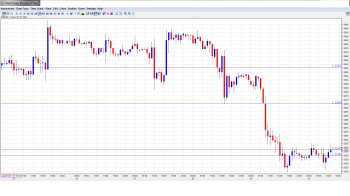EUR/USD has steadied after sharp losses on Thursday, as markets jitters over a US strike against Syria have eased. The pair is trading in the mid-1.32 range in Friday’s European session. On Thursday, US releases looked good, as GDP posted a strong gain and Unemployment Claims were very close to the forecast. Friday is busy, but there are no major releases out of the Eurozone or the US. In the Eurozone, German Retail Sales declined sharply while Italian Unemployment numbers showed some improvement. Over in the US, we’ll get a look at inflation, PMI and consumer confidence data later in the day.
Here is a quick update on the technical situation, indicators, and market sentiment that moves euro/dollar.
EUR/USD Technical
- In the Asian session, EUR/USD was a quiet, touching a high of 1.3255 line and consolidating at 1.3248. The pair is unchanged in the European session.
Current range: 1.3240 to 1.33.
Further levels in both directions:
- Below: 1.3240, 1.3175, 1.31, 1.3050, 1.30 and 1.2940.
- Above: 1.33, 1.3350, 1.3415, 1.3450, 1.3520, 1.3590 and 1.37.
- 1.3240 is under strong pressure from the pair. 1.3175 is next.
- 1.3300 continues to provide resistance. 1.3350 follows.
EUR/USD Fundamentals
- 6:00 German Retail Sales. Exp. 0.5%, actual -1.4%.
- 8:00 Italian Quarterly Unemployment Rate. Exp. 12.1%, actual 12.1%.
- 8:00 Italian Monthly Unemployment Rate. Exp. 12.2%, actual 12.0%.
- 9:00 Eurozone CPI Flash Estimate. Exp. 1.4%.
- 9:00 Eurozone Unemployment Rate. Exp. 12.1%.
- 9:00 Italian Preliminary CPI. Exp. 0.2%.
- 12:30 US Core PCE Price Index. Exp. 0.2%.
- 12:30 US Personal Spending. Exp. 0.3%.
- 12:30 US Personal Income. Exp. 0.3%.
- 13:00 US FOMC Member James Bullard Speaks.
- 13:45 US Chicago PMI. Exp. 53.2 points.
- 13:55 US Revised UoM Consumer Sentiment. Exp. 81.2 points.
- 13:55 US Revised UoM Inflation Expectations.
For more events and lines, see the Euro to dollar forecast.
EUR/USD Sentiment
- Euro steadies as Mid-East tensions recede: The markets reacted nervously this week to a likely US strike against Syria, after a chemical attack in the war-torn country killed hundreds of civilians. The euro dropped sharply, losing about 150 points over the course of the past two days. However, there is now speculation that the attack could be postponed until mid-September. On Thursday, the British parliament voted by a narrow margin not to join any US attack on Syria. This complicates President Obama’s attempts to solidify a coalition before taking military action. The markets have steadied and the euro is holding its own against the dollar in Friday trading.
- GDP, Employment numbers improve: US releases have zigzagged this week, but Thursday’s key releases looked solid. Preliminary GDP posted another strong gain of 2.5% in Q1, after a 2.4% rise in Q1. Unemployment Claims dropped slightly to 331 thousand, just shy of the estimate of 330 thousand. The strong numbers will likely increase speculation that the Federal Reserve could taper QE in September rather than later in the year, so we could see the dollar post gains against the euro and other currencies.
- German data sputters: German data continues to look weak. On Thursday, Unemployment Change jumped from -7 thousand in July to 7 thousand in August. The markets had expected another decline of -5K. Friday brought no relief as Retail Sales declined 1.4%, well off the estimate of a 0.5% gain. National elections are just a few weeks away, and domestic economic problems could hurt Chancellor Angela Merkel, who is seeking a third straight term in office.
- Fed mum over QE tapering timing: The Federal Reserve has kept very quiet about when it might taper QE, but recent statement from Fed policymakers underscore the divisions regarding the timing of such a dramatic move. Dennis Lockhart, head of the Atlanta Fed, said that tapering could start in September, but only if US data justified such a move. There was a more hawkish statement from James Bullard, head of the St. Louis Fed. Bullard said that there was no need for the Fed to rush into QE tapering. Meanwhile, the uncertainty over QE tapering has boosted the US dollar, raised the yields on US treasury bonds and led nervous investors to pull billions of dollars out of emerging markets. With September just around the corner, we could see strong volatility in the markets as speculation over QE heats up.

